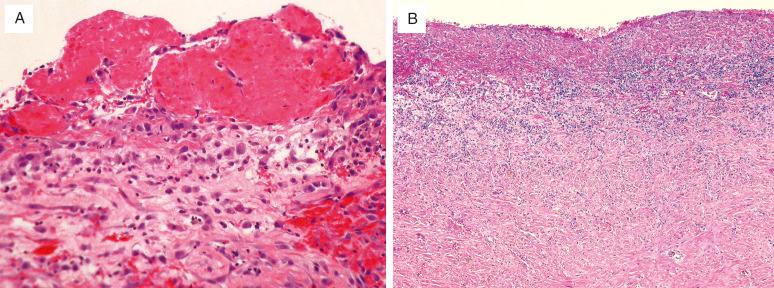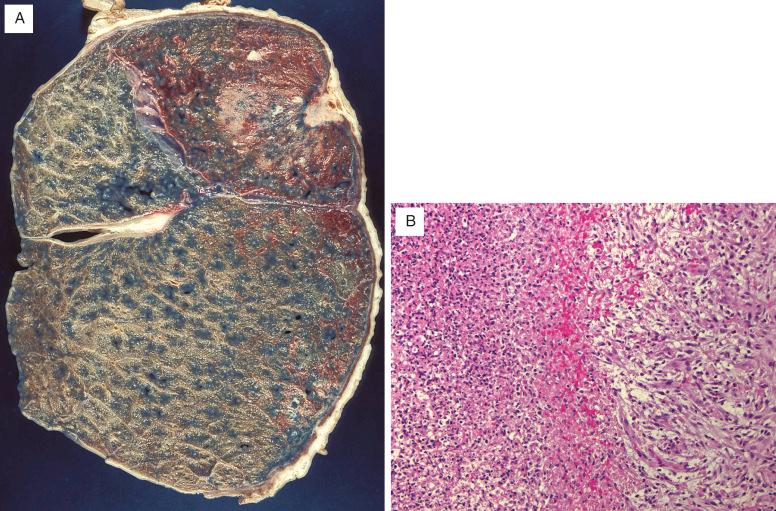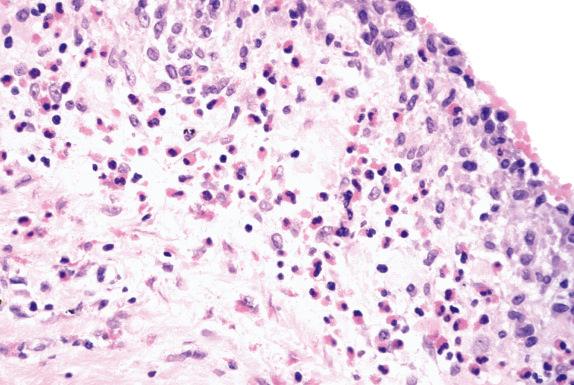Physical Address
304 North Cardinal St.
Dorchester Center, MA 02124
Nonspecific repair reaction of an exudative or bloody pleural effusion
Symptoms are related to the primary disease or the presence of fluid and include cough, chest pain, sputum production, and varying degrees of shortness of breath
The course of the effusion depends on its etiology and the responsiveness of the underlying condition to therapy
Many effusions require drainage
Diagnostic thoracentesis can be performed in cases of significant parapneumonic effusions to differentiate infected, complicated effusions from uncomplicated effusions
Tube thoracostomy is necessary for treatment of complicated parapneumonic effusions
Decortication is reserved for cases with inadequate drainage or persistent pleural thickening with associated pulmonary function deficits
Exudative phase: dilated pleural capillaries, foci of fibrin, mesothelial cell enlargement
Fibrinous phase: layered fibrin, granulation tissue, mesothelial cell proliferation
Organizing phase: progressive fibrosis, chronic inflammatory cell infiltrate
Malignant mesothelioma
Organization of a pleural effusion is a nonspecific repair reaction to an exudative or bloody effusion stemming from a variety of causes. Whereas the majority of exudative effusions are named according to their etiology (ie, postradiation effusion), any pleural effusion that is associated with an acute inflammatory condition in the adjacent lung is termed a parapneumonic effusion. The term complicated parapneumonic effusion refers to a parapneumonic effusion that does not resolve with antibiotic therapy and requires tube thoracostomy for resolution.
Effusions can develop at any age and are associated with a multiplicity of diseases and treatments. Parapneumonic effusions are quite common and are found in up to 40% of patients with bacterial pneumonia. Symptoms may be related to the primary disease or the presence of the fluid and include cough, chest pain, sputum production, and varying degrees of shortness of breath. Chest radiographs enable diagnosis.
Grossly, a layer of gray or tan material typically coats the pleura. The histologic changes can be divided into exudative, fibrinous, and organizing stages. In the exudative stage, the pleural capillaries are dilated, and there are reactive changes with enlargement of mesothelial cells, which remain in a single layer; small deposits of fibrin can be found adherent to the pleura. The fibrinous stage is characterized by layered fibrin deposition, granulation tissue, and mesothelial reaction ( Fig. 34.1A ). The mesothelial cells may be cytologically atypical, but the atypia is confined to the area of the organizing effusion, and mesothelial cells are never found in the underlying adipose tissue. The organizing stage is characterized by progressive fibrosis and a chronic inflammatory cell infiltrate ( Fig. 34.1B ). The fibrous tissue is most dense adjacent to the chest wall.

Active organizing pleuritis may be confused with malignant mesothelioma, particularly in small biopsy specimens. Important differential diagnostic points include the layered appearance of the reactive process compared with the diffuse cellularity, or deep cellularity, of malignant mesothelioma. Mesotheliomas will invade underlying adipose tissue, whereas invasive mesothelial cell proliferation is absent in reactive processes.
The course of the effusion depends on its etiology and the responsiveness of the underlying condition to therapy. Many effusions require drainage, and some will require surgical intervention. Diagnostic thoracentesis is appropriate in cases of significant parapneumonic effusions to differentiate infected, complicated effusions from uncomplicated effusions, with the former requiring tube thoracostomy. In effusions complicating other diseases, drainage is initiated on a case-by-case basis. Decortication is reserved for those patients who have inadequate drainage after tube thoracostomy and for those patients with persistent pleural thickening and significant pulmonary function deficits.
Bacterial infection of the pleural space with acute inflammatory response
Symptoms (cough, sputum production) are often related to an adjacent pneumonic process, and signs of sepsis (fever and leukocytosis) are commonly present
Treatment includes tube thoracostomy and antimicrobial therapy
Decortication is performed if pleural sepsis is not controlled by drainage
Bronchopleural fistula is an important potential complication
Exudative stage: dilated pleural capillaries, foci of fibrin, mesothelial cell enlargement
Fibrinous stage: layered fibrin with a massive infiltrate of neutrophils, granulation tissue, mesothelial cell proliferation
Organizing stage: progressive fibrosis, chronic inflammatory cell infiltrate
Cultures and special stains for bacteria and fungi may reveal an etiologic agent
Necrotic neoplasms
An empyema is a bacterial infection of the pleural space with accompanying acute inflammatory exudate.
Approximately 60% of empyemas develop from parapneumonic effusions. At the present time, anaerobic organisms are more commonly isolated than aerobic organisms, with most patients having more than one organism identified. Postsurgical (pneumonectomy) empyemas are an important clinical problem, and empyemas uncommonly follow thoracentesis. Empyema is infrequently found as a complication of pleural rheumatoid nodules, probably because of the formation of bronchopleural fistulas with necrosis of the nodules.
Symptoms (cough, sputum production) may be those of the adjacent pneumonic process, when empyema complicates a parapneumonic effusion. Other symptoms and signs include fever and leukocytosis, expectoration of pleural fluid (if a bronchopleural fistula is present), air–fluid levels in the pleural space, or drainage of purulent material from an incision or needle tract.
Grossly, the pleura is usually coated with a layer of tan or yellow-green material ( Fig. 34.2A ). Microscopically, empyemas progress through the same general stages as uncomplicated effusions, but the fibrinous stage is characterized by a thick layer of neutrophils ( Fig. 34.2B ). Chemical analysis of pleural fluid shows a low pH (less than 7.2) and a low glucose level (less than 30 mg/dL).

Cultures and special stains for bacteria and fungi can be performed. Organisms may or may not be identified, depending on the specific agent and the success of antibiotic therapy.
An empyema must be differentiated from a necrotic tumor. If possible, the organism(s) responsible should be identified by culture and histochemical stains for bacteria and fungi.
Tube thoracostomy combined with antibiotic therapy represents the usual primary therapy; multiple tubes may be required if more than one locule is present. Decortication may be necessary if pleural sepsis is not controlled by the tube thoracostomies. Development of a bronchopleural fistula is an important complication; if the infected pleural fluid is not drained exteriorly, it is likely to drain interiorly and produce a severe bronchopneumonia.
Reactive pleural process characterized by pleural infiltration by numerous eosinophils
Most commonly induced by pneumothorax, but also found with some effusions, hemothorax, and infections with parasites and fungi
Infective processes are treated with antimicrobial agents and drainage
Cases secondary to pneumothorax require no treatment
Eosinophilic pleuritis is a reactive pleural process characterized by the presence of numerous eosinophils.
Eosinophilic pleuritis is classically induced by pneumothorax and is often seen in resected bullae. It can, however, also be found as a consequence of a pleural effusion or hemothorax, or in settings of infections with parasites (hydatid disease, amebiasis, ascariasis) or fungi. Occasionally, it may be associated with an adjacent eosinophilic pneumonia.
Numerous eosinophils infiltrate the pleura and are often accompanied by macrophages, giant cells, and other inflammatory cells ( Fig. 34.3 ). Reactive mesothelial cell proliferation may also be present.

Although Langerhans cell histiocytosis may be considered in the differential diagnosis, it is a lung parenchymal disease rather than a pleural disease and consists of cysts with stellate nodular aggregates of Langerhans cells accompanied by other inflammatory cells and variable degrees of fibrosis.
Infective eosinophilic pleuritis must be treated with antimicrobial agents and drainage. Simple reactive eosinophilic pleuritis due to pneumothorax has no consequence, whereas those cases secondary to hemothorax may require drainage or decortication.
Become a Clinical Tree membership for Full access and enjoy Unlimited articles
If you are a member. Log in here